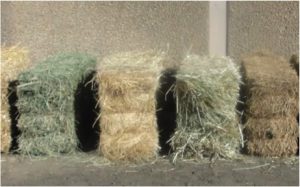From the January 2019 Issue of the University of Minnesota Extension – Horse Newsletter….
CHOOSING ALTERNATIVE FEEDSTUFFS
By: Marcia Hathaway, PhD, University of Minnesota

Photo Credit: Krishona Martenson, PhD, University of Minnesota
Horse owners may be exploring alternative feedstuffs due to high hay costs, poor quality hay, and/or challenges associated with finding sufficient quantities of hay. When possible, quality hay should make up a large portion of a horse’s diet. However, the following alternatives can replace hay, in partial or in whole, when needed. Always consider the pros and cons when selecting an appropriate alternative feedstuff, and before feeding, consult your an equine nutritionist and/or veterinarian.
Last year’s hay stored properly
Pros: Nutrition content is similar to the current year’s hay except vitamins and high in fiber which supports the horse’s digestive tract.
Cons: Contains little or no vitamin A and E.
Hay cubes
Hay cubes are generally alfalfa or a mix of alfalfa and grass. You can purchase hay cubes from your local local farm supply or feed store.
Pros: Nutritional content is similar to hay, nutrition information is present on the feed label, high in fiber which supports the horse’s digestive system, may have less dust and less waste than hay, you can use it as a total replacement to hay, and can be easier to handle, transport and store.
Cons: May be costly, it takes horses less time to eat it than hay, horses may overeat, and may contain feed binders.
Alfalfa pellets
Pros: Nutritional content is similar to hay, high in fiber, may have less dust and waste than hay, you can use it as a total replacement.
Cons: Horses spend less time eating, and horses may overeat.
Beet pulp
Pros: High in digestible energy, relatively high in calcium, high in fiber, which supports the horse’s digestive tract, palatable, and you can feed up to 5 to 10 pounds daily (a partial replacement to hay).
Cons: May need to supplement phosphorus to balance calcium.
Vacuum-packed, chopped alfalfa
Pros: Nutritional content similar to alfalfa, high in fiber, which supports the horse’s digestive tract, you can use it as a total replacement to hay.
Cons: You’ll need to feed a greater mass than hay, and may mold after opening the bag (e.g. feed it within 2 to 3 days).
Complete feeds
Complete feeds are commercially produced feeds that contain a mixture of grains and roughages.
Pros: Nutritionally balanced, adequate in fiber, and you can use as a total replacement.
Cons: It takes horses less time to eat than hay, may not have enough total fiber, and you may need to divide it into small meals.
Rice bran
Pros: High in fat and phosphorus, high in fiber, which supports the horse’s digestive tract, and you can use it as a partial replacement to hay.
Cons: you must provide a calcium supplement to balance the phosphorus content, and it must be stabilized to prevent spoilage.
For more information on alternative feedstuffs, click here.
For more information provided by the University of Minnesota Extension efforts, CLICK HERE